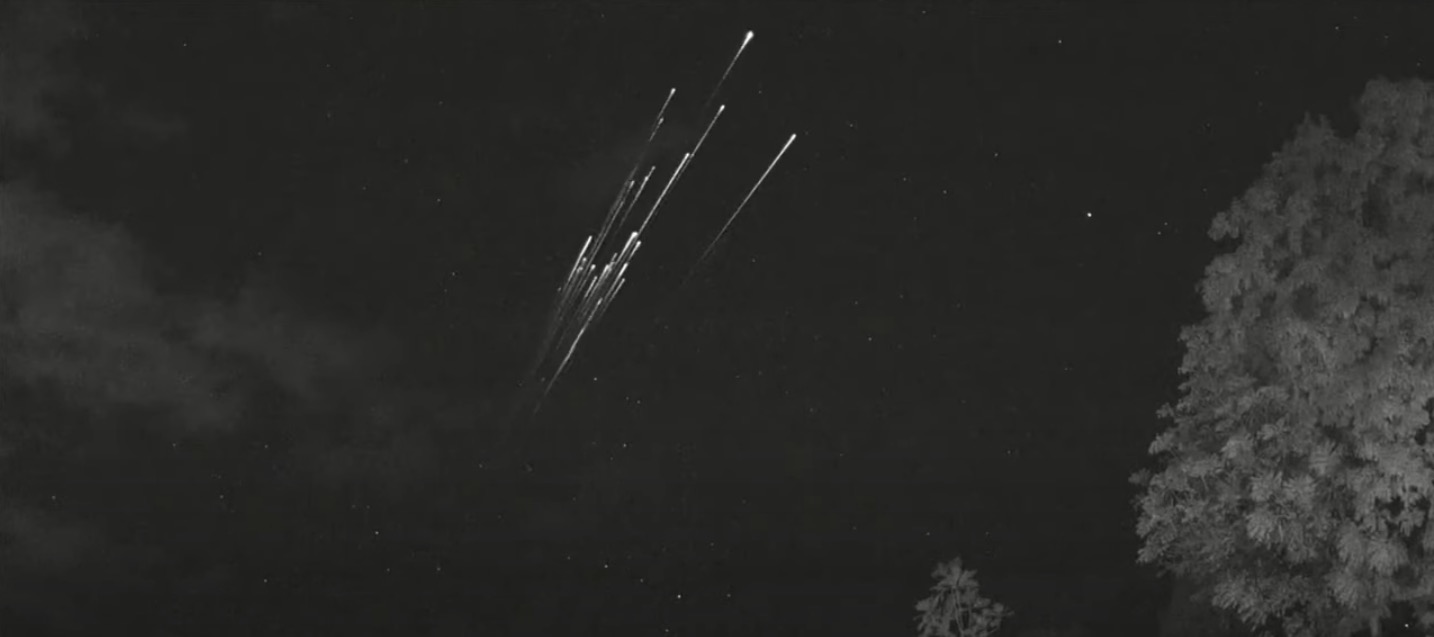A dramatic video serves as a memorial to a star-crossed satellite that lived fast and died very young.
SpaceX launched 49 satellites to low Earth orbit on Feb. 3 to further beef up the company's huge and growing Starlink internet megaconstellation. But most of those newly lofted spacecraft will never beam any broadband signals down, thanks to a powerful sun eruption.
Charged particles from that solar blast spawned a geomagnetic storm on Feb. 4, substantially increasing the density of Earth's atmosphere and thus the drag experienced by the new, low-flying Starlink batch, SpaceX representatives reported on Tuesday (Feb. 8). As a result, up to 40 of the 49 satellites are expected to come crashing back to Earth over the coming days.
Related: SpaceX's Starlink satellite megaconstellation launches in photos

Some of them have already given up the ghost, including an unlucky satellite that burned up in the skies over Puerto Rico early Monday morning (Feb. 7). That spacecraft's fiery demise was captured on video by a camera operated by the Sociedad de Astronomia del Caribe, a Puerto Rico-based nonprofit organization.
The three-minute video shows two distinct breakup events about one minute apart. These could be two pieces of the same satellite or two separate spacecraft that had been traveling in the same orbital plane, said Marco Langbroek, a satellite tracker based in the Netherlands. Either way, it's pretty clear that the reentering objects were part of the Feb. 3 Starlink launch, he stressed.
"One clue is that the orbital plane of this launch was over Puerto Rico near the time of the event, and the direction of movement (SW-NE) matches it," Langbroek wrote Wednesday (Feb. 9) in a blog post analyzing the video.
Breaking space news, the latest updates on rocket launches, skywatching events and more!
"To get even more certainty, I did some astrometry on the footage and fitted a rough circular orbit to the measured positions.The rough orbital fit I get — I measured three fragments — yield[s] orbital inclinations in the range of 54-56 degrees: Starlink satellites are in 53.2-degree inclined orbits, so this is close enough (given the error margin) to conclude that the reentering object fits with the Starlink orbital plane," he added. "So there is very little doubt that this was a Starlink satellite reentering."
There will likely be plenty more fireworks to come from this unlucky launch, and you may even be able to see some of them.
"Forty (40!) satellites reentering in only a week or so is unique," Langbroek wrote. "The coming week, the chances of seeing a satellite reentry are therefore larger than usual for anyone between 53 [degrees north latitude] and 53 S. So keep an eye on the sky!"
Mike Wall is the author of "Out There" (Grand Central Publishing, 2018; illustrated by Karl Tate), a book about the search for alien life. Follow him on Twitter @michaeldwall. Follow us on Twitter @Spacedotcom or on Facebook.
Join our Space Forums to keep talking space on the latest missions, night sky and more! And if you have a news tip, correction or comment, let us know at: community@space.com.

Michael Wall is a Senior Space Writer with Space.com and joined the team in 2010. He primarily covers exoplanets, spaceflight and military space, but has been known to dabble in the space art beat. His book about the search for alien life, "Out There," was published on Nov. 13, 2018. Before becoming a science writer, Michael worked as a herpetologist and wildlife biologist. He has a Ph.D. in evolutionary biology from the University of Sydney, Australia, a bachelor's degree from the University of Arizona, and a graduate certificate in science writing from the University of California, Santa Cruz. To find out what his latest project is, you can follow Michael on Twitter.
